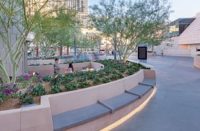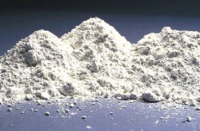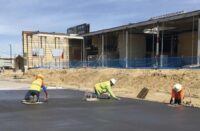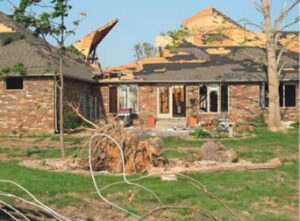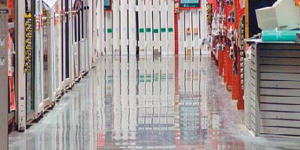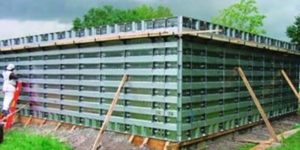
Would you like to increase performance by 1,000 percent? Now you can, using a new type of concrete that is up to 10 times stronger than common concrete mixtures. This impressive feat can be accomplished with Ductal, a revolutionary, ultra-high-performance material that delivers up to 30,000 psi compressive strength and rivals the strength of metal.
While steel maintains a significant advantage in tensile and flexural strength, Ductal has reduced that gap as well. Normal concrete, for example, has almost no flexural strength, yet Ductal offers flexural strengths up to 6,000 psi. This is closely related to the material’s amazing ability to bend (within limits) without breaking — a property called “ductility” and the inspiration for its name. Where ordinary concrete is brittle and shatters catastrophically when it fails, Ductal will stretch as it reaches its load limit, making structures more robust and providing extra margins of safety.

Clearly, this is exciting news for leading-edge structural engineers and architects who challenge themselves to “do more with less.” It should be exciting news, too, for everyone interested in decorative concrete. That’s because the performance of the new material demands a reassessment of the aesthetic and functional possibilities of concrete construction.
The material’s strength enables it to be used in very thin sections. This, in turn, reduces the weight of a structure and allows the use of larger pieces with fewer joints. Ductal is extremely fluid and self-placing, allowing it to be cast into complex shapes. It produces surface textures and appearances unmatched by conventional concretes. And it is so durable that it can be used without fear of the elements for enduring structures and monuments.

Big performance — small particles
Ductal is made by Lafarge, a leading global producer of construction materials, and is available through Lafarge North America. Ductal contains many of the same materials used in ordinary concrete — portland cement, silica fume, fine aggregate, and superplasticizers, and is blended with either metallic or poly-vinyl alcohol (PVA) fibers. Each ingredient, however, is tweaked to supercharge their collective performance. For example, fine aggregates are supplemented with very fine silica particles in the form of quartz flour, thereby filling the gaps between other materials to increase density and cementation.
The scientists at Lafarge explain that Ductal enters the realm of nanotechnology. Ordinary cementitious materials do not react completely when mixed with water. Ductal overcomes this by using ultra-fine particles of cementitious materials and manipulating their particle size distribution. At such a small scale, material behaviors change and, as a result, Ductal’s performance is an order of magnitude beyond conventional technologies.
Low water/cementitious material ratios characterize high-strength concrete, and Ductal’s w/cm is exceptionally low. Lafarge has had to institute special batching and mixing techniques to make the mixtures work with high fluidity.
The result is Ultra-High Performance Fiber Reinforced Concrete with the unwieldy abbreviation “UHPFRC.” I prefer the French terminology, “Beton Fibre Ultra-hautes Performances” because its abbreviation, “BFUP” sounds like a nasally pronounced “Beef Up” and suggests what Ductal does to concrete.
Visually, Ductal produces an exceptionally fine-grain surface that mirrors the texture of the mold material. Cast it against fabric, for example, and it will look like fabric. Sandblasting can be used to roughen the surface, something that may be useful if one is trying to match the appearance of conventional concrete.
Ductal is produced as either a white or gray powder and can be integrally colored in a wide range of shades. Fabrications are striking in the visual uniformity of their coloration. Rigorous quality control, watertight molds that prevent leaching, and a fluid mixture that does not segregate or form bug holes, flow lines or segregation can make the concrete remarkably free from mottling.
Interesting effects can also be produced by swirling together different colors; the rheological characteristics of Ductal enable the colors to mix without blending, as would happen with ordinary concrete mixtures.
Business opportunities
Lafarge is taking a cautious approach towards introducing the technology, preferring to view it as a service as well as a product. “We have developed a range of Ductal mixtures, and work with each customer to understand what they are trying to do,” explains Vic Perry, vice president and general manager, Ductal/Lafarge North America. “If Ductal is appropriate for their project, we engineer a mixture that meets their specific requirements and work with them to assure proper fabrication procedures are followed.”
According to Perry, “Ductal is a solution looking for problems.” He says that someone might want to use Ductal because of its outstanding strength-to-weight performance, its low permeability and high resistance to abrasion, corrosion, freeze-thaw, and other forms of deterioration, or to create a shape or appearance not possible with other materials. “Ideally,” he says, “we look for applications where Ductal can solve several of these problems simultaneously. Otherwise, it is likely that another material could be a better solution.” Ductal, he says, can be used as an alternative to metals, plastics, resin, and ceramics as well as conventional concrete.
Ductal is so new and so different that, Perry continues, “You have to forget almost everything you know about concrete and start from scratch.” Equipment, mixing, casting and curing techniques are all different from conventional production. Instead of ordinary formwork, for example, it is necessary to use completely watertight molds to contain the highly fluid Ductal mixtures. To date, Lafarge has only authorized the use of the material for precasting since the quality assurance required can be best achieved under factory conditions.
If Lafarge agrees that a potential project or application is suitable for Ductal, the company may license a customer to use the material, and then work closely with them to design and test prototypes and launch production. Because a small project can take as much front-end work as a larger project, Perry says Lafarge is most receptive to proposals for large projects or products with multiple production runs. But he acknowledges that his firm makes exceptions for “interesting projects that help us showcase the material or learn more about Ductal’s capabilities.”

What do you want to build?
This means you probably won’t be using Ductal for paving or slabs on grade. Or does it?Ductal gives us freedom to re-imagine how we build. I am visualizing thin precast concrete panels with tongue-and-groove edges. They are about 60 inches by 60 inches and are supported only at corners where they rest on posts driven into the ground. Sure, the concrete panels might cost more than four inches of ready mix, but the cost might be offset by reduced substrate preparation and labor. Now, imagine casting the panels with color and texture, eliminating the need for applied finishes and passive reinforcement, and you can start to visualize the possibilities when you BEEF-UP concrete.
Is this idea realistic? Time will tell. But decorative concrete artisans are not likely to sit around and wait for others to pave the path forward. Thinking about Ductal and what you want to build is just the stimulus you need to boast your imagination by 1,000 percent or more. Go for it!
